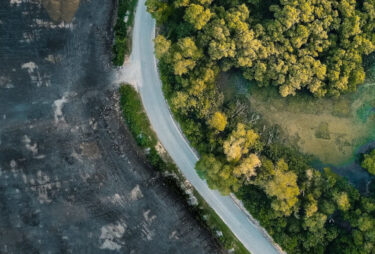
Contents
- Biodiversity & Nature Loss
- Avoiding Carbon Tunnel Vision
- The Business Case for Nature
- Taking the Next Step
- Contact Us
Share this article
Nature is not merely a scenic backdrop, but the bedrock of our quality of life and the global economy. In fact, the World Economic Forum (WEF) consistently ranks biodiversity loss and ecosystem collapse among the top global risks, reflecting the widespread concern among experts and leaders about the potential for devastating consequences, including disruptions to supply chains, resource scarcity, and increased operational costs.
In this article, we explore why, more than ever, businesses need to begin addressing their nature risk amidst the current biodiversity crisis.
The Current State of Biodiversity and Nature Loss
Biodiversity encompasses the variety of life on Earth and is critical for maintaining the resilience and functionality of nature. The Intergovernmental Science-Policy Platform on Biodiversity and Ecosystem Services (IPBES) framework breaks biodiversity down into three levels:
- Genes: Genetic diversity within species is crucial for adaptation and survival. It provides the raw material for evolution and adaptation to changing environments, ensuring species’ survival and resilience to diseases and environmental changes.
- Species: This refers to the variety and abundance of species within ecosystems, encompassing species richness (the number of species) and species evenness (the distribution of individuals among species). It plays a critical role in maintaining ecosystem stability, productivity, and functionality. Species diversity supports essential ecological processes like pollination, nutrient cycling, and the dynamics of food webs, ensuring that ecosystems remain resilient and productive.
- Ecosystems: Each ecosystem provides unique services, such as water purification, climate regulation, and soil formation, essential for human well-being and economic activities. Ecosystems consist of diverse habitats, like forests, wetlands, and oceans, which provide essential services like water filtration, carbon storage, and pollination.
Unfortunately, the current rate of biodiversity decline is unprecedented in human history, with around 1 million animal and plant species now at the brink of extinction. This alarming pace of species loss, driven primarily by human activities, has raised serious concerns about the future of the planet’s ecosystems and the essential services they provide.
The accelerating decline in biodiversity is driven primarily by five key human-induced factors:
- Land and Sea-Use Change: The conversion of natural habitats such as forests, wetlands, and oceans into agricultural or urban areas leads to habitat loss and fragmentation, disrupting ecosystems and displacing species.
- Direct Exploitation of Organisms: Overfishing, overhunting, and unsustainable logging practices deplete populations, disrupt food webs, and can lead to species extinction.
- Climate Change: Rising temperatures, changing precipitation patterns, and ocean acidification alter habitats, forcing species to adapt or migrate and increasing the risk of extinction.
- Pollution: The release of pollutants into air, water, and soil contaminates ecosystems, harming wildlife and disrupting natural processes.
- Invasive Alien Species: Non-native species introduced to new environments can outcompete native species, disrupt ecosystems, and cause economic damage.
Business operations play an important part in each of these human-induced factors, and thus business must have a role in the coordinated efforts needed to address the biodiversity crisis. Fortunately, by engaging in nature-positive action, businesses can not only reduce their impact on biodiversity and nature loss, but can also enhance their business resilience to future nature and climate challenges.
The Importance of Avoiding “Carbon Tunnel Vision”
The global response to environmental concerns has recently been dominated by a focus on climate change, sometimes leading to “carbon tunnel vision.” This narrow focus can overshadow the critical importance of nature, including biodiversity and ecosystem services, for both planetary health and business resilience.
In fact, the interactions between climate change, human activities, and nature are a complex and interconnected web. Human activities, such as burning fossil fuels and converting natural ecosystems, drive climate change, which in turn drives nature loss. Nature loss, such as deforestation and land-use change, further exacerbates climate change by releasing stored carbon.
These challenges do not exist in isolation; they interact, exacerbate, and amplify each other’s effects in a dangerous feedback loop, posing significant risks to both ecosystems and businesses in all sectors. This cycle impacts people through extreme weather, sea-level rise, and reduced food security.
Conversely, natural systems help regulate the climate, and the implementation of solutions that center nature can help address these climate change effects. For example, nature-based solutions such as reforestation, wetland restoration, and sustainable land management are essential for carbon sequestration and climate change mitigation and offer numerous co-benefits for biodiversity, water security, and community resilience.
There is no “net zero” without nature
By broadening their perspective beyond carbon emissions, businesses can unlock a more holistic approach to environmental stewardship. Integrating nature-based solutions into their strategies allows companies to address the interconnected challenges of climate change and biodiversity loss simultaneously, fostering a more sustainable and resilient future for both the planet and their operations.
The Business Case for Nature
Businesses have both impacts and dependencies on nature. A dependency is an environmental asset or ecosystem service that a person or organisation relies on to function – and it can, in turn, affect an investor’s perception of business value. Impacts, which can be positive or negative, refer to a change in the quality or state of nature.
Companies that negatively impact nature create a ripple effect, elevating risk for other companies and, in cases where they operate simultaneously on both sides of that relationship, for themselves. Conversely, they can also develop technologies and other solutions to protect, regenerate, and restore ecosystems, creating new opportunities for investors.
For companies and investors operating in industries that are highly dependent on natural capital, like agriculture, fishery and aquaculture, and forestry, ignoring risks and opportunities stemming from this loss could pose serious negative impacts. Understanding the interconnectedness of environmental areas is crucial for businesses to effectively assess and mitigate their risks, adapt to a changing planet, and identify opportunities for sustainable growth.
Despite this potential impact, studies find that many lenders, investors, and companies appear to insufficiently account for nature-related risks and opportunities. The 2023 Nature Benchmark of 350 companies in food and agriculture by the World Benchmarking Alliance found that only 28% of food and agriculture companies report progress on nature-related targets, despite being among the most nature-dependent industries. Moreover, zero companies holistically assess and disclose their dependencies on nature.
Similarly, only 19% of the finance institutions reviewed by the Global Canopy Programme (primarily asset managers, pension funds, insurers, and banks) had deforestation policies for all relevant deforestation-risk commodities, while 68% had no policies at all.
Taking the Next Step
Addressing the biodiversity crisis requires urgent, coordinated efforts to mitigate human-induced effects on biodiversity and the climate. For businesses, this means integrating biodiversity considerations into their operations and value chains. By adopting sustainable practices, reducing their ecological footprint, and investing in nature-positive initiatives, companies can not only help preserve the rich diversity of life but also enhance their resilience and competitiveness.
Protecting biodiversity is not just an environmental imperative but a strategic business opportunity that can drive innovation, reduce risks, and build a sustainable future for all.
Our experts empower organisations to accelerate towards a nature-positive future by developing solutions that align business goals with earth system boundaries, strengthening the resilience of enterprises and ecosystems alike.
This article was written in collaboration with Catherine Lange, Claire McCollough, Tyler Moran, and Cate Starmer as part of the University of Vermont Sustainable Innovation MBA program. Our experts in Nature Positive Solutions recently worked with the program to develop research into the intricate relationship between businesses and nature, exploring the risks and opportunities associated with natural capital and ecosystem services, and providing actionable strategies for companies to build resilience and thrive in an increasingly uncertain future.
We are the world’s leading purpose driven, digitally enabled, science-based activator. And always welcome inquiries and partnerships to drive positive change together.




